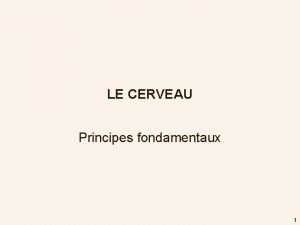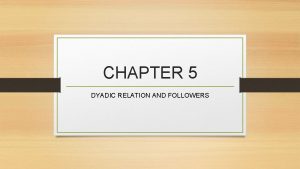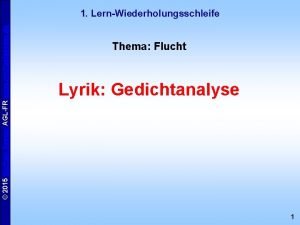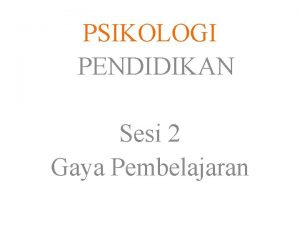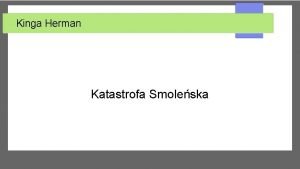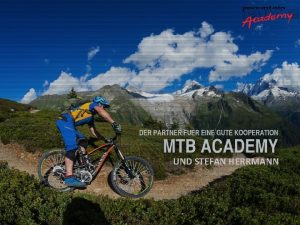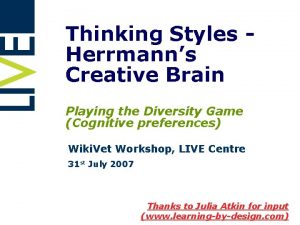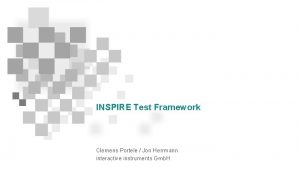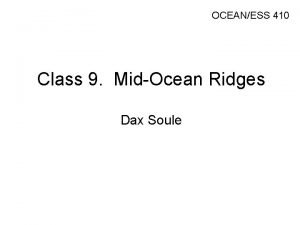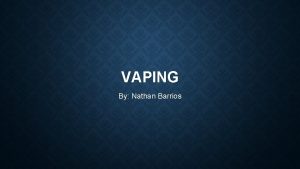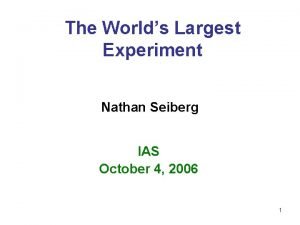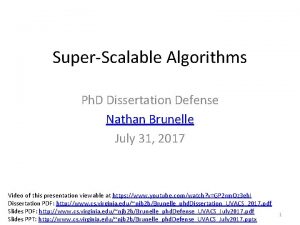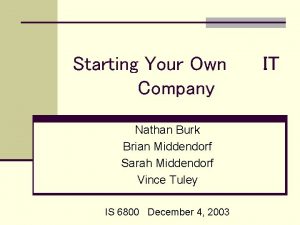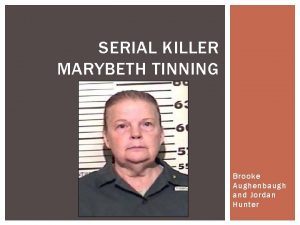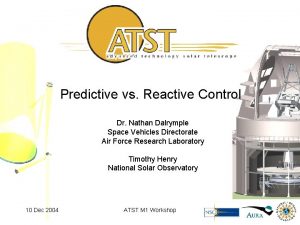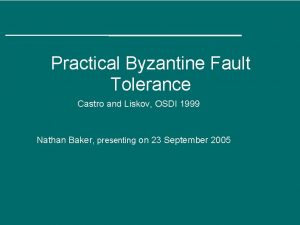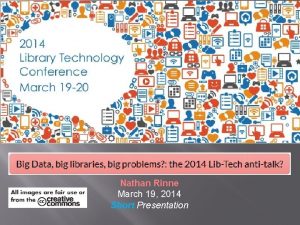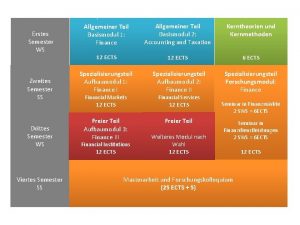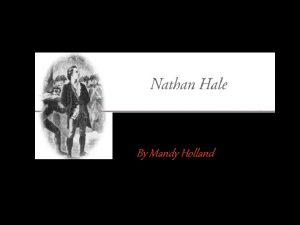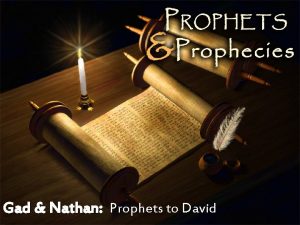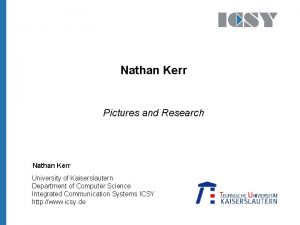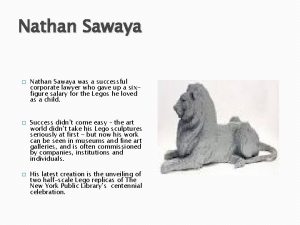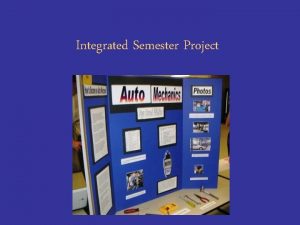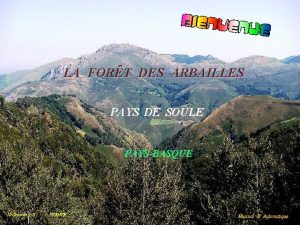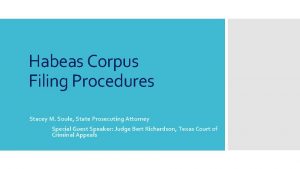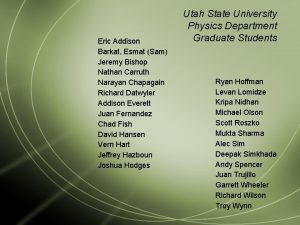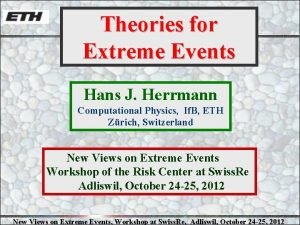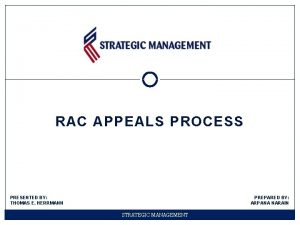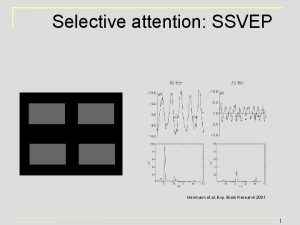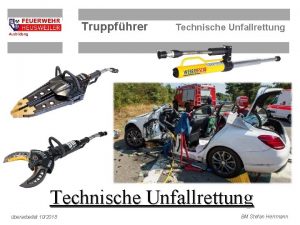JEREMY SOULE SEMESTER PROJECT NATHAN HERRMANN JEREMY SOULE






















- Slides: 22

JEREMY SOULE SEMESTER PROJECT NATHAN HERRMANN

JEREMY SOULE: CHILD SUPERSTAR • Jeremy Soule was born on December 19, 1975 to a music teacher father and a graphic design mother. • First gave signs of interest in symphony at the age of 5. • He would often fit music into everything in his life. Often he would write music notation in the edged of his schoolwork. • He began taking private lessons from professors of Western Illinois University at the age of six • By the end of high school he claimed to have gained the equivalent of a masters degree in music.

Soule learned to work for what he wanted when he was young. His father had a large record collection and he as well wanted to collect his own CDs. His family was not well off so if he wanted something that means that he would have to work for it. Soule spent hours mowing lawns but he said its was all worth it to hear the music that he liked. This also taught him that if he wanted to write good music he would have to work for it. As a child not only was Soule influenced by music but also by video games. He believed that all games could benefit from a better musical score and that it would bring much more depth to the experience.

FIRST WORKS • Soule never received a diploma from the university. • He made a demo tape of what he himself believed a video game score should sound like. • He send his demos to Lucas. Arts but they never responded and he assumed that it was because they did not accept solicitations. • The second company, Square, was quick to respond and within two weeks he was working for them. • His first project was Secrets of Evermore. • This soundtrack features background such as wind or rain included in the orchestral score. This made for a mellow and laid back orchestral composition. • Soule was never completely satisfied with the music because of the limitations that the program used by square had.

• Eventually Square moved to California and Soule left to work for a brand new company called Humungous Entertainment. • Here he worked on a series of child adventure games such as Putt-Putt and Pajama Sam • While working here he met Sam Tailor and was assigned to work on a new project called Total Anihiliation.

• During the development process of Total Annihilation Soule insisted that in order to stand out from the other games of the genre the musical score would have to be an orchestral composition as opposed to the techno that other games were using. • Soules persistence on this point paid off and the music to the game was the best that he had done yet • His work on Total Annihilation won him his first award of “Best Music” in 1997

INDEPENDENT COMPOSER • Soule began to work as an independent composer and in the year 2000 formed his own company with his brother, Julian, called Soule Media which later changed to Artistry Entertainment. • His first project in his new company was Icewind Dale, a Role-Playing game. • This as well was a great success and won the award of Best Music from IGN and Gamespot. • He later wrote the music for the Harry Potter video games. • Chamber of Secrets and Prisoner of Azkaban would win “Best score” from the British Academy of Film & Television Arts.

• IN 2005 Soule worked on the title Elder Scrolls III: Morrowind • This title earned him an award nomination from the Academy of Interactive Arts and Science. • Bethesda was so pleased with the music that they returned to Soule for the sequels to the game; Elder Scrolls IV: Oblivion and Elder Scrolls V: Skyrim • Other Major titles were Knights of the Old Republic, Guild Wars and Warhammer 40, 000: Dawn of War.

ACOMPLISHMENTS • The year 2012 has been the best year yet for Soule. • He won 3 awards for his work on Skyrim • Top Video Game from ASCAP • Best Original Vocal – Choral from Game Audio Network Guild • Hall of Fame from The British Classic FM • It would be nominated for 4 more awards. • In the same year his work on Guild Wars 2 would win Award of Excellence from Global Music Awards.

DIRECTSONG • In 2005 the Soule brothers formed another company called Direct. Song • Through this they offered downloads of Soules works. • By 2007 the company had gained more than one million registered customers. • Despite the astounding growth of the company many have had poor experience when purchasing music from them such that some may be forced to wait over a year for CD’s. • Though he is loved for his music there are many who are disappointed with his management of Direct. Song. • Recently he announced that he would not be returning to compose for the Guild Wars series and the responses were mixed. While they will miss his sound they will not miss his treatment of fans.

PHILOSPOPHY • Soule places great emphasis on symphony orchestra and sais that “the orchestra is the ultimate instrument. I find that is has the ability to define nearly every human emotion in existence. ” • When composing Soule likes to have great visuals to be able to capture the feel of the game for which he is composing and mostly likes to work with companies that are intuitive and daring. • This desire has brought him to focus more on Role-Playing Games as opposed to other types of games.

SKYRIM: MAIN THEME • For the pieces of Skyrim Soule wanted to have it sound very Nordic • There is a lot of Percussion and vocal chanting played along with a lot of brass. • The end of the main theme was intended to emphasize the a great view of mountains with dragons.

SKYRIM: DRAGONBORN “MAIN THEME” • 0: 00 – Piece begins with deep percussion to set the tempo and the feel of battle. Focus is placed on the first and third beat of music. • 0: 07 – Vocals begin chanting and strings enter with quick staccato notes on the fourth beat. Chant continues to grow in volume building up anticipation. • 0: 22 – Brass come in with for one measure then are joined by the choir to build up anticipation. Rising notes and increased volume makes sure that goal is achieved. • 0: 36 – Introduce theme of the dragonborn. Choir of all male voices sing strong emphasizing the beat with the horns supporting. • 0: 51 – Trumpets play descending notes while Horns play the Elder Scrolls Melody. Transition to

• 1: 05 – Vocals return in the front. Brass embellishes with quick high rising notes. • 1: 19 – Transition by the horns along with vocal cheers. • 1: 26 – Bridge with high female voices rising over the low chanting of the male voices. Sounds beautiful but with the undertone of something dark. • 1: 41 – Male voices begin their rising chant to build anticipation all while the female voices continue to sing high above it all. String play their staccato to add to the tension and horns rise as if to lead to the next part. • 1: 55 – Variation of Elder Scrolls Melody acts as a break down leading up to the main melody. • 2: 11 – The Elder Scrolls theme repeats with vocals carrying the melody. Trumpets are playing along with the vocals. 2: 31 – Dragonborn melody returns with strings supporting the vocals and horns playing scales. • 2: 46 – Transition with horns and cheers returns. • 2: 53 – Outro begins and continues till the end of the song. High female voice returns followed by string and horns. This was written to accent the trailer of the game. • 3: 38 – Percussion returns to give transition into the next piece.

SKYRIM: SOVNGARDE • Sovngarde is supposed to be the afterlife. • 0: 00 – Begins with percussion similar to the end of Dragonborn • 0: 13 – Male vocals hum along in time with the percussion to give a darker sound and marching almost like a funeral march. • 0: 26 – Vocals join in for polyphony singing. In the key of G# to introducing the main theme. • 0: 52 - Humming returns but with more embellishment. • 1: 02 – Vocals change to the key of F. Polyphony becomes more elaborate

• 1: 58 - Vocals again change to G# • 2: 31 – Loud chant not only a key change to A, but as well the tempo change. Polyphony becomes more elaborate. • 2: 59 – Vocals change to A# again. For a moment the two keys overlap. Main theme returns in this key and more embellished with 3 separate singing parts. • 3: 27 – Loud chants brings it all to a close.

GUILD WARS 2 • The main theme of Guild Wars 2 is what is heard every time the game is opened. Its quick and not very long but it holds a lot of power. • In all good stories there is a struggle between good and evil and Fear not this night is meant to illustrate that point.

GUILD WARS 2: MAIN THEME • 0: 00 – Strings and choir start off strong with the chorus. Synthesizer holds out a low tone. • 0: 11 – Horns play a counter melody to the strings and vocals. • 0: 22 - Chimes and a symbol swell bring a transition to the song. • 0: 31 – Low strings play a variation while violins are playing legato and second violins are play staccato. • 0: 50 – Variation of the counter melody is sung by the vocals • 0: 59 – Horns enter with counter melody but with a new motif on the end to transition to the outro • 1: 14 – Outro is played by repeating the melody first by the strings then passed to the vocals. Horns crescendo to a final note to end.

GUILD WARS 2: FEAR NOT THIS NIGHT • 0: 00 – Intro piano hinting at the melody and violins softly supporting in the back. Played in the key of D. • 0: 08 – Cello enters and supports the piano melody. • 0: 23 – All strings build in volume while piano maintains melody. • 0: 46 – Short pause to bring in the main melody and singer. Main theme and chorus is given here by vocals with piano accompany. Violins continue to play softly in the back. • 1: 00 – Verse cuts the melody short and begins. The first part of the verse is sang at a D. • 1: 14 – Verse is repeated but the vocals begin with an F#.

• 1: 28 – Pre chorus begins on an A giving a feeling of rising progression in the lyrics. Embellishment from backup vocals is given along with staccato violins. • 1: 41 – Chorus returns starting on B. It’s interesting to note that the motif of the motif is B D F# B and the verse follows nearly that same patter. The verse also uses some Ab. • 1: 55 – Transition to set up the second verse. • 2: 29 – Verse 2 begins again but the piano plays a different variation from the first. Again the verse maintains the same progression as before • 2: 49 – Pre Chorus repeats but with new backup vocals to embellish with the singer. • 3: 03 – Chorus repeats. • 3: 16 – Half way through the chorus the key changes to F#

• 3: 21 – Another key change to G. Tricky tricky Jeremy Soule • 3: 28 – a final change to E for the rest of the song. So many progressive changes to the key brings a feeling of uncertainty and discomfort. Finally coming to rest at E we can find some measure of resolution. • 3: 30 – Chorus is repeated again in E but the last lyrics are sung by the backup vocals. • 3: 44 – Final chorus is repeated. Bringing back the transition lyrics from the second chorus leading into the outro. • 4: 24 – Outro to the end of the song.

SOURCES SITED "Capturing the Dragon: The Music of Jeremy Soule. " Eurogamer. net. Web. 3 Nov. 2014. . http: //www. imdb. com/name/nm 0815819/bio? ref_=nm_ov_bio_sm "Jeremy Soule. " Wikipedia. Wikimedia Foundation, 11 Jan. 2014. Web. 3 Nov. 2014. . http: //www. kekaiart. com/guild-wars-2. html http: //minnesota. publicradio. org/display/web/2013/11/14/jeremy-soule-and-guild-wars-2 -on-top-score "Pajama Sam. " Humongous Entertainment Games Wiki. Web. 5 Nov. 2014. . "Sorrowful Music - IGN. " IGN. Web. 3 Nov. 2014. "Speed Demos Archive - The Elder Scrolls III: Morrowind. " Speed Demos Archive - The Elder Scrolls III: Morrowind. Web. 5 Nov. 2014. . "Total Annihilation Wiki. " Total Annihilation Wiki. Web. 5 Nov. 2014. .
 Y quién soy yo
Y quién soy yo Ned herrmann
Ned herrmann Curphy and roellig followership model
Curphy and roellig followership model Heimatlos max herrmann neiße analyse
Heimatlos max herrmann neiße analyse Howard herrmann
Howard herrmann 4 gaya pembelajaran
4 gaya pembelajaran Kinga herrmann
Kinga herrmann Leslie herrmann
Leslie herrmann Stefan hermann bike academy
Stefan hermann bike academy Ned herrmann
Ned herrmann Jon herrmann
Jon herrmann Jeanne herrmann
Jeanne herrmann Dax soule
Dax soule Nathan dickinson
Nathan dickinson Nathan barrios
Nathan barrios Nathan seiberg
Nathan seiberg Nathan brunelle
Nathan brunelle Brian middendorf
Brian middendorf Joe tinning today
Joe tinning today Nathan dalrymple
Nathan dalrymple Nathan liskov
Nathan liskov Nathan rinne
Nathan rinne Nathan dalrymple
Nathan dalrymple

